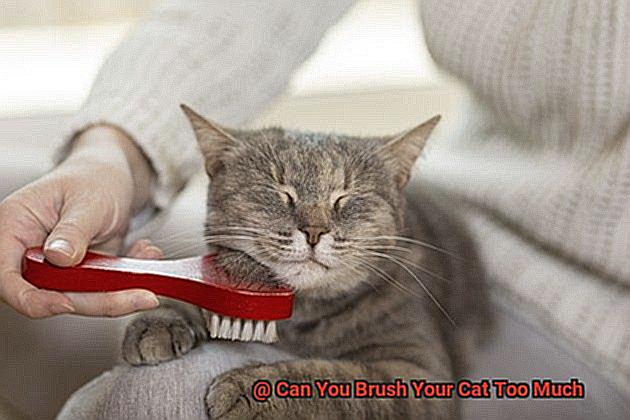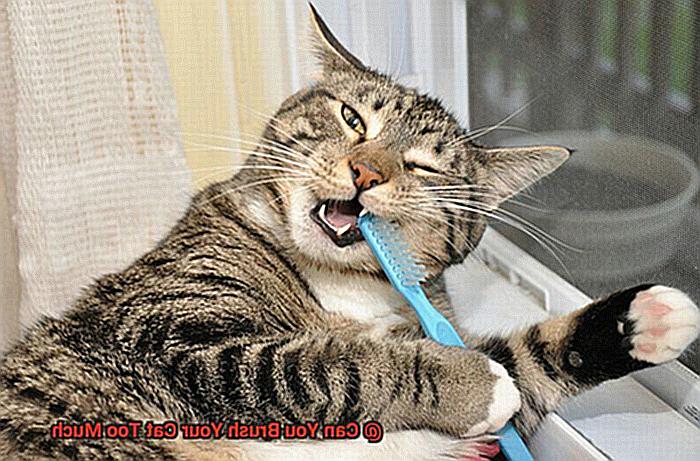As a cat owner, you’re probably well aware of the importance of grooming your furry friend. But have you ever wondered if there’s such a thing as too much brushing? After all, you don’t want to unintentionally harm your feline companion while trying to keep them looking and feeling their best.
In this blog post, we’ll explore the question of whether or not you can brush your cat too much. We’ll take a closer look at the factors that can influence how often you should groom your cat and provide some helpful tips for ensuring that your feline friend stays healthy and happy.
Before we dive into the details, let’s start with a surprising fact: did you know that cats spend around 30% of their waking hours grooming themselves? That’s right – our feline companions are serious about self-care. This just goes to show how important grooming is for cats’ overall health and well-being.

But back to the question at hand: can you overdo it when it comes to brushing your cat? The answer is yes – excessive brushing can lead to skin irritation, hair loss, and even behavioral issues in some cases. However, the amount of grooming needed varies depending on factors like your cat’s coat type, age, and overall health.
So how do you strike the right balance between too much and not enough brushing? With the right approach and frequency, grooming can be a pleasurable bonding experience for both you and your furry friend. So let’s get started on exploring how to give your cat the perfect amount of TLC they need.
How Often Should You Brush Your Cat?
Not only does it keep their coat shiny and healthy, but it also helps to create a strong bond between you and your furry friend. However, it’s crucial to note that there is such a thing as too much brushing.
The frequency of brushing your cat depends on several factors, including their breed, hair length, and shedding habits. For example, if your feline friend has long hair or a thick undercoat, they will require more frequent brushing than short-haired cats. It’s generally recommended to brush your cat at least once a week, but some breeds may require daily brushing.

While regular brushing is essential for your cat’s coat health, it’s crucial to do so in moderation. Overbrushing can lead to skin irritation and hair loss in cats. If you notice redness or irritation on your cat’s skin after brushing, it may be a sign that you’re brushing too often or too aggressively. Moreover, excessive brushing can strip the natural oils from your cat’s coat, leading to dry and brittle hair.
It’s essential to pay attention to your cat’s behavior during grooming sessions. If they start to become agitated or restless, it may be a sign that they’ve had enough brushing for the day. Always be gentle when brushing your cat and avoid using too much pressure.
So how often should you brush your cat? A good rule of thumb is to brush them once a day or every other day for no more than 10-15 minutes. Using the right type of brush for your cat’s coat is also crucial. For instance, slicker brushes are great for removing tangles and mats in long-haired cats, while rubber curry brushes are ideal for short-haired cats.
What Types of Brushes are Best for Cats?
One key aspect of cat care is grooming, and choosing the right brush for your cat’s coat is crucial. With so many types of brushes on the market, it can be overwhelming to determine which one is best suited for your cat. In this article, we’ll explore the top brushes for cats with different coat types to help make your decision easier.
Short Hair Cats

For cats with short hair, bristle or rubber brushes are ideal. The gentle natural bristles of a bristle brush effectively remove loose hair and dirt from your cat’s coat without irritating their skin. Rubber brushes have soft rubber bristles that are perfect for cats who don’t like the feel of metal brushes. Both options leave your cat’s coat shiny and healthy-looking.
Medium or Long Hair Cats
Cats with medium or long hair require a more specialized brush. A slicker brush is the perfect tool to remove tangles and mats in medium and long-haired cats. Its fine, tightly packed wires can get deep into your cat’s fur without causing any discomfort. While a wide-toothed comb can also be used to remove tangles and mats, it’s not as effective as a slicker brush.
Thick Undercoat Cats

If your cat has a thick undercoat, a deshedding tool may be necessary. These tools are designed to remove loose hair from your cat’s undercoat, which can help prevent matting and reduce shedding. Deshedding tools come in various shapes and sizes, so it’s vital to choose one that fits your cat’s size and coat type.
It’s important to remember that overbrushing can harm your cat’s skin, cause hair loss, and strip natural oils from their coat. Therefore, it’s recommended to brush them once a day or every other day for no more than 10-15 minutes using the right type of brush for their coat.
What Are the Benefits of Brushing Your Cat?
One of the most important ways you can do this is by regularly brushing your cat. Not only does brushing help keep your cat’s coat clean and shiny, but it also has numerous benefits for their physical and mental wellbeing.
By brushing your cat regularly, you can remove loose fur and dander from their coat, reducing shedding and preventing hairballs. This can lead to a healthier digestive system and a cleaner home. But that’s not all. Brushing also stimulates blood flow to your cat’s skin, promoting a healthy coat and reducing the risk of skin irritations.
Furthermore, regular brushing sessions with your feline friend can help you detect any lumps, bumps or injuries on their skin early on, which could require veterinary attention. Early detection means prompt treatment and better outcomes for your beloved kitty.
In addition to physical benefits, brushing your cat can also have a positive impact on their mental wellbeing. Cats are naturally clean animals, and grooming helps them feel relaxed and content. It is also an excellent way to strengthen the bond between you and your cat, promoting a feeling of trust and love.
However, it is essential to remember that over-brushing can be harmful to your cat’s health and may even lead to behavioral issues such as anxiety or aggression. To avoid this, it is recommended that you brush your cat once or twice a week for short periods of time.
What Are the Risks of Overbrushing Your Cat?
Regular brushing can help achieve this, but be cautious not to overdo it. Overbrushing your cat can pose some risks that may negatively impact their health and wellbeing.
One of the most significant risks is skin irritation and damage. Cats have sensitive skin, and excessive brushing can cause redness, itching, and even sores. Imagine how uncomfortable it would be if someone brushed your hair so hard that your scalp became sore – the same applies to cats.
Another risk is hair loss. Brushing too hard or too frequently can cause the hair to break off or fall out, which can leave your cat with bald patches and an uneven coat. This can be unsightly and affect their self-esteem – we all want our cats to feel confident and proud of their appearance.
Overbrushing can also lead to stress and anxiety for your cat. Some cats may not enjoy being brushed, and frequent brushing can make them agitated or fearful. This can lead to behavioral issues such as aggression or avoidance, which we want to avoid as attentive cat owners.
Moreover, overbrushing can strip the natural oils from your cat’s fur, leaving it dry and brittle. These oils help to keep your cat’s coat healthy and shiny, but too much brushing can remove them, leading to a dull and lackluster appearance. Additionally, dry skin can be itchy and uncomfortable for your feline friend.
To ensure a healthy balance when it comes to brushing your cat, aim for once a day for short periods of time using a soft brush or comb that won’t irritate their skin. Pay attention to your cat’s body language – if they seem uncomfortable or agitated, stop immediately.
Tips for Brushing Your Cat Properly
One way to achieve this is by brushing them regularly. However, brushing your cat improperly can cause discomfort and harm to your furry friend. To help you brush your cat like a pro, we have compiled some tips that will make the experience positive and beneficial for both you and your cat.
Choose the Right Brush
Different cats have different types of fur, so it’s essential to use the appropriate brush for their coat type. For example, a slicker brush works great for long-haired cats, while a bristle brush is more suitable for short-haired breeds. Using the right brush will help remove loose hair, prevent hairballs, and keep their coat looking shiny and healthy.
Start Slowly
If your cat is not used to being brushed, start slowly and gently. Gradually increase the amount of time you spend brushing as they become more comfortable. Use gentle strokes around sensitive areas like the belly and tail and avoid pulling or tugging on knots or mats. Brushing your cat should be a positive experience for both of you.
Watch for Signs of Discomfort
Keep an eye out for any vocalizations or aggressive behavior from your cat during brushing. If your cat seems uncomfortable or distressed, stop brushing and try again later. It’s essential to pay attention to your cat’s body language to avoid causing them any discomfort or harm.
Don’t Overdo It
While regular brushing is important for maintaining a healthy coat, overbrushing can cause skin irritation and discomfort. A good rule of thumb is to brush your cat once or twice a week for no more than 10-15 minutes. Following a regular brushing schedule will help you maintain a healthy coat without causing any harm or discomfort.
Adjust Accordingly
Each cat is unique and may require different grooming needs based on their breed, age, and health status. Pay attention to your cat’s grooming needs and adjust accordingly. For example, if your cat is shedding excessively, you may need to brush them more frequently to prevent hairballs.
NQNo-zWjXXI” >
Conclusion
In summary, grooming your cat is an essential aspect of their overall health and wellbeing. However, it’s crucial to find the right balance between too much and too little brushing. Overbrushing can lead to skin irritation, hair loss, and even behavioral issues. The amount of grooming required depends on various factors such as your cat’s age, coat type, and overall health.
It’s recommended to brush your cat at least once a week, but some breeds may require daily brushing. Using the right type of brush for your cat’s coat is also crucial. For short-haired cats, bristle or rubber brushes are ideal; for medium or long-haired cats, slicker brushes work best; while deshedding tools may be necessary for cats with thick undercoats.
Regular brushing has numerous benefits for your cat’s physical and mental wellbeing. However, overbrushing can pose risks such as skin irritation and damage, hair loss, stress and anxiety for your cat. Therefore it’s vital to follow a regular brushing schedule that won’t cause any discomfort or harm to your feline friend.
By following these tips on how to brush your cat correctly and finding the right balance between grooming frequency and technique, you can ensure that your furry friend stays healthy and happy while enjoying bonding moments together.







